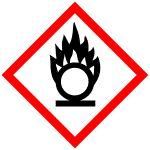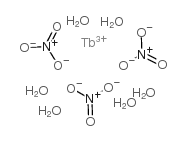星空app:13451-19-9
| Name | terbium(3+),trinitrate,hexahydrate |
|---|---|
| Synonyms |
Terbium trinitrate hexahydrate
EINECS 233-132-4 MFCD00149868 |
| Boiling Point | 83?C at 760 mmHg |
|---|---|
| Melting Point | 89.3 °C |
| Molecular Formula | H12N3O15Tb |
| Molecular Weight | 453.03200 |
| Exact Mass | 452.95200 |
| PSA | 262.02000 |
| LogP | 0.46650 |
| Vapour Pressure | 49.8mmHg at 25°C |
| Storage condition | 0-6°C |
Synonym:Nitric acid, terbium (3+) salt texahydrat Section 2 - COMPOSITION, INFORMATION ON INGREDIENTS
Risk Phrases: 8 Section 3 - HAZARDS IDENTIFICATION EMERGENCY OVERVIEW
Contact with combustible material may cause fire.The toxicological properties of this material have not been fully investigated.Hygroscopic (absorbs moisture from the air). Potential Health Effects Eye: May cause eye irritation. Skin: May cause skin irritation. Ingestion: May cause irritation of the digestive tract. The toxicological properties of this substance have not been fully investigated. Inhalation: May cause respiratory tract irritation. The toxicological properties of this substance have not been fully investigated. Chronic: Not available. Section 4 - FIRST AID MEASURES Eyes: Flush eyes with plenty of water for at least 15 minutes, occasionally lifting the upper and lower eyelids. Get medical aid. Skin: Get medical aid. Flush skin with plenty of water for at least 15 minutes while removing contaminated clothing and shoes. Ingestion: If victim is conscious and alert, give 2-4 cupfuls of milk or water. Never give anything by mouth to an unconscious person. Get medical aid. Inhalation: Remove from exposure and move to fresh air immediately. Get medical aid. Notes to Physician: Section 5 - FIRE FIGHTING MEASURES General Information: As in any fire, wear a self-contained breathing apparatus in pressure-demand, MSHA/NIOSH (approved or equivalent), and full protective gear. Strong oxidizer. Contact with other material may cause fire. Extinguishing Media: Use water only! Section 6 - ACCIDENTAL RELEASE MEASURES General Information: Use proper personal protective equipment as indicated in Section 8. Spills/Leaks: Vacuum or sweep up material and place into a suitable disposal container. Section 7 - HANDLING and STORAGE Handling: Ground and bond containers when transferring material. Avoid contact with skin and eyes. Empty containers retain product residue, (liquid and/or vapor), and can be dangerous. Avoid contact with clothing and other combustible materials. Avoid ingestion and inhalation. Use only in a chemical fume hood. Do not pressurize, cut, weld, braze, solder, drill, grind, or expose empty containers to heat, sparks or open flames. Storage: Store in a cool, dry place. Store in a tightly closed container. Section 8 - EXPOSURE CONTROLS, PERSONAL PROTECTION Engineering Controls: Use adequate ventilation to keep airborne concentrations low. Exposure Limits CAS# 13451-19-9: Personal Protective Equipment Eyes: Wear appropriate protective eyeglasses or chemical safety goggles as described by OSHA's eye and face protection regulations in 29 CFR 1910.133 or European Standard EN166. Skin: Wear appropriate protective gloves to prevent skin exposure. Clothing: Wear appropriate protective clothing to prevent skin exposure. Respirators: Follow the OSHA respirator regulations found in 29 CFR 1910.134 or European Standard EN 149. Use a NIOSH/MSHA or European Standard EN 149 approved respirator if exposure limits are exceeded or if irritation or other symptoms are experienced. Section 9 - PHYSICAL AND CHEMICAL PROPERTIES Physical State: Solid Color: white Odor: Odorless pH: Not available. Vapor Pressure: Not available. Viscosity: Not available. Boiling Point: Not available. Freezing/Melting Point: 89.3 deg C Autoignition Temperature: Not available. Flash Point: Not available. Explosion Limits, lower: Not available. Explosion Limits, upper: Not available. Decomposition Temperature: Solubility in water: soluble in water Specific Gravity/Density: Molecular Formula: N3O9Tb.6H2O Molecular Weight: 453.02 Section 10 - STABILITY AND REACTIVITY Chemical Stability: Stable under normal temperatures and pressures. Conditions to Avoid: Incompatible materials, combustible materials, exposure to moist air or water. Incompatibilities with Other Materials: Strong reducing agents, strong acids. Hazardous Decomposition Products: Nitrogen oxides. Hazardous Polymerization: Has not been reported. Section 11 - TOXICOLOGICAL INFORMATION RTECS#: CAS# 13451-19-9: WY9625000 LD50/LC50: CAS# 13451-19-9: Oral, rat: LD50 = >5 gm/kg. Carcinogenicity: TERBIUM(III)NITRATE HEXAHYDRATE - Not listed by ACGIH, IARC, or NTP. Other: See actual entry in RTECS for complete information. Section 12 - ECOLOGICAL INFORMATION Section 13 - DISPOSAL CONSIDERATIONS Dispose of in a manner consistent with federal, state, and local regulations. Section 14 - TRANSPORT INFORMATION IATA Shipping Name: NITRATES, INORGANIC, N.O.S. Hazard Class: 5.1 UN Number: 1477 Packing Group: II IMO Shipping Name: NITRATES, INORGANIC, N.O.S. Hazard Class: 5.1 UN Number: 1477 Packing Group: II RID/ADR Shipping Name: NITRATES, INORGANIC, N.O.S. Hazard Class: 5.1 UN Number: 1477 Packing group: II Section 15 - REGULATORY INFORMATION European/International Regulations European Labeling in Accordance with EC Directives Hazard Symbols: O Risk Phrases: R 8 Contact with combustible material may cause fire. Safety Phrases: S 17 Keep away from combustible material. WGK (Water Danger/Protection) CAS# 13451-19-9: No information available. Canada None of the chemicals in this product are listed on the DSL/NDSL list. CAS# 13451-19-9 is not listed on Canada's Ingredient Disclosure List. US FEDERAL TSCA CAS# 13451-19-9 is not on the TSCA Inventory because it is a hydrate. It is considered to be listed if the CAS number for the anhydrous form is on the inventory (40CFR720.3(u)(2)). SECTION 16 - ADDITIONAL INFORMATION N/A |
星空app:CHEMICAL IDENTIFICATION
星空app:HEALTH HAZARD DATAACUTE TOXICITY DATA
|
| Symbol |


GHS03, GHS07 |
|---|---|
| Signal Word | Danger |
| Hazard Statements | H272-H315-H319-H335 |
| Precautionary Statements | P220-P261-P305 + P351 + P338 |
| Personal Protective Equipment | dust mask type N95 (US);Eyeshields;full-face particle respirator type N100 (US);Gloves;respirator cartridge type N100 (US);type P1 (EN143) respirator filter;type P3 (EN 143) respirator cartridges |
| Hazard Codes | O: Oxidizing agent;Xi: Irritant; |
| Risk Phrases | R8 |
| Safety Phrases | S17-S26-S36/37/39 |
| RIDADR | UN 1477 5.1/PG 3 |
| WGK Germany | 2 |
| RTECS | WY9625000 |
| Packaging Group | III |
| Hazard Class | 5.1 |

